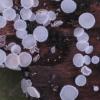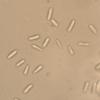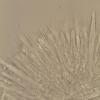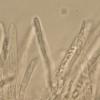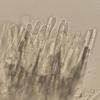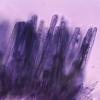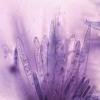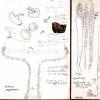
16-03-2014 22:00
Hello,I found this species a few months ago but ha

08-12-2025 13:39
Thomas Læssøehttps://svampe.databasen.org/observations/10572899

07-12-2025 16:07
Arnold BüschlenHallo, ich habe in einer Moos-Aufsammlung (epiohy

05-12-2025 17:33
 Bruno Coué
Bruno Coué
Bonjour, je serais heureux de recueillir votre avi

07-12-2025 09:24
De la pasada semana en Galicia EspañaEn el suelo

06-12-2025 00:19
 Viktorie Halasu
Viktorie Halasu
Hello, would anyone have this article, please? An
Lachnum
Bometon Javier,
08-07-2014 22:43
 En madera de planifolio indeterminada.
En madera de planifolio indeterminada.Esporas 7-10 X 2-2,5 um, cilindricas.contenido aceite 0.
Ascas 52-65 X 5-6 um, IKI +, croziers +
Parafisis anchamente lanceoladas 7-8 um, que sobresalen de las ascas 10-20 um, Vbs -.
Pelos 80-100 X 4-4,5 um, septados, Vbs -
Parece próximo a L. virgineum, pero las esporas de esta colección parecen más anchas.
Alguna idea?
Saludos
Javier
Hans-Otto Baral,
08-07-2014 23:20

Re : Lachnum
I measured sometimes *6-9 x 2-2.5 µm in L. virgineum, so I think this is right.
Zotto
Zotto
Bometon Javier,
08-07-2014 23:39

Re : Lachnum
Gracias Zotto, siempre que la había estudiado antes las esporas eran más estrechas por eso tenía dudas.
Saludos
Javier
Saludos
Javier
Hans-Otto Baral,
09-07-2014 09:55

Re : Lachnum
The length of 10 µm is possible too.
Václav Pouska,
13-07-2014 11:33
Re : Lachnum
Hello,
I have a similar problem with Lachnum papyraceum collected on Picea abies (mountain forest in central Europe). Spore size in Nordic Macromycetes vol. 1 is 4-6 x 1-1.5 um; in an older description (Saccardo 1889) the length is 3-7 um.
Many spores are bigger in my collections, e.g. (6-) 8 x 2, 10 x 2 um, but some 5 x 1.5 or 8 x 1.5 also occur (these are inside asci and may not be mature). The width of most spores is rather 2 than 1.5 um. Everything else seems to fit L. papyraceum, but I do not have an experince with these species (do not have a more comprehensive key than Nordic Macromycetes).
Thanks,
Vaclav
I have a similar problem with Lachnum papyraceum collected on Picea abies (mountain forest in central Europe). Spore size in Nordic Macromycetes vol. 1 is 4-6 x 1-1.5 um; in an older description (Saccardo 1889) the length is 3-7 um.
Many spores are bigger in my collections, e.g. (6-) 8 x 2, 10 x 2 um, but some 5 x 1.5 or 8 x 1.5 also occur (these are inside asci and may not be mature). The width of most spores is rather 2 than 1.5 um. Everything else seems to fit L. papyraceum, but I do not have an experince with these species (do not have a more comprehensive key than Nordic Macromycetes).
Thanks,
Vaclav
Hans-Otto Baral,
13-07-2014 11:39

Re : Lachnum
This is mainly a problem of living vs. dead spores. Did you measure them from fresh samples in water?
The few records I have of that species vary in spore length betwee short and long-spored.
Here is an example, and I so far found no other name for it.
My spore range of the long-spored variant is:
7.5-11.7 x 1.7-2.6
Important is that the paraphyses and hairs contain strongly refractive VBs which cause the red-brown colouration in senescent apothecia.
The few records I have of that species vary in spore length betwee short and long-spored.
Here is an example, and I so far found no other name for it.
My spore range of the long-spored variant is:
7.5-11.7 x 1.7-2.6
Important is that the paraphyses and hairs contain strongly refractive VBs which cause the red-brown colouration in senescent apothecia.
Václav Pouska,
30-07-2014 21:25
Re : Lachnum
I did not have an opportunity to microscope fresh samples. I understand now that spores and especially asci in fresh material are longer than in dry samples. I always start with water and I added Melzer's reagens to check if pores in asci turn blue. It does not seem that spore size differs in water and in Melzer in dry material. I could see granulose content of some hairs and paraphyses (e.g. in Melzer) but I do not know if it is common in dry samples.
Older apothecia became brownish after drying, and hymenium is quite dark in some cases. Only very young sporocarps are whitish even when dry.
Thank you for nice drawings.
Older apothecia became brownish after drying, and hymenium is quite dark in some cases. Only very young sporocarps are whitish even when dry.
Thank you for nice drawings.
Hans-Otto Baral,
30-07-2014 21:36

Re : Lachnum
Your observations are correct. When you study dry samples the spores are dead after some time (sometimes only after several months or years). Then the spore and ascus size does not change in MLZ.
But please use IKI for the apical ring because of the red reaction in some species.
The VB-guttules (vacuolar, not lipidic) in the living state are impossible to trace in herbarium material in Lachnum. Any granules you see in dried samples rehydrated in water or MLZ are of different origin and taxonomically useless.
The VBs induce the red-brown colour change in the dry or senescent state. Young apothecia when cautiously dried best keep the whitish original colour.
Zotto
But please use IKI for the apical ring because of the red reaction in some species.
The VB-guttules (vacuolar, not lipidic) in the living state are impossible to trace in herbarium material in Lachnum. Any granules you see in dried samples rehydrated in water or MLZ are of different origin and taxonomically useless.
The VBs induce the red-brown colour change in the dry or senescent state. Young apothecia when cautiously dried best keep the whitish original colour.
Zotto

